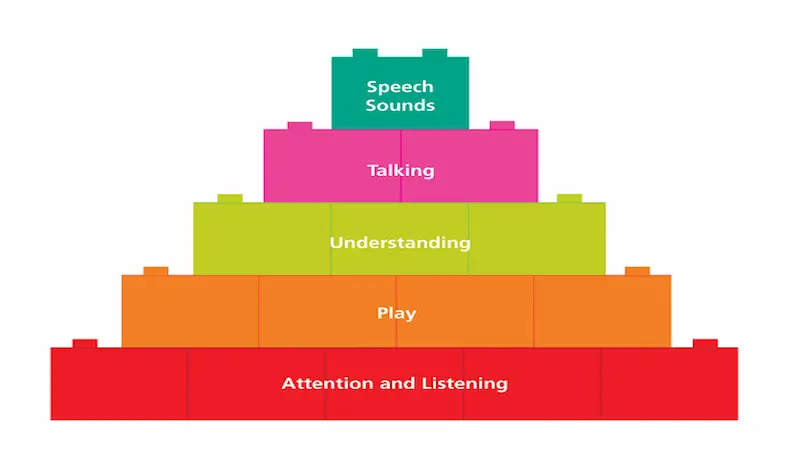Children’s language development is a critical aspect of their overall growth and learning. From the moment they begin to communicate, language plays a fundamental role in shaping their thoughts, emotions, and relationships. This introduction explores the significance of language development in children and highlights its lasting impact on their cognitive and social development.
Table of contents
The Building Blocks of Language
Language, the most powerful tool of human communication, is a complex system with various interconnected building blocks for kids that enable us to convey our thought of the day for kids, emotions, and ideas. Let’s take a concise journey through the three fundamental components of language development:

Phonological Development: From Cooing to Pronunciation
Babies enter the world with the innate ability to acquire language. The first step in their linguistic journey is phonological development, where they explore the sounds of their native tongue. From adorable coos and babbling to imitating sounds they hear, infants gradually refine their vocal skills. By their first birthday, they typically utter simple words like “mama” and “dada,” marking their progress in phonological mastery.
Vocabulary Growth: First Words and Word Spurts
Around the age of 1 to 2 years, toddlers experience an exciting phase called “word spurts.” During this time, their vocabulary expands rapidly, and they start to comprehend and use more words every day. From basic nouns like “ball” and “dog” to action words like “eat” and “run,” their language acquisition flourishes.
Grammar and Syntax: From Simple Sentences to Complex Structures
As children grow, they begin to grasp the rules of grammar and syntax. Initially, they form simple sentences, combining words to convey basic ideas. As their cognitive abilities develop, so does their capacity to construct more intricate and meaningful sentences.
Language Milestones
Language development is a fascinating journey that every child embarks on from infancy through early childhood. From their first adorable babbling sounds to form complex sentences, the milestones reached by children are essential markers of their cognitive growth mindset books for kids.

When Do Babies Say Their First Words?
During the first year of life, babies go through a remarkable period of language development. Around the age of 9 to 12 months, most infants typically utter their first words. These initial words are often simple and relate to their immediate environment, such as “mama,” “dada,” “ball,” or “dog.”
Toddler Talk: Understanding the Two-Word and Telegraphic Stages
Between the ages of 18 to 24 months, toddlers enter the two-word stage, where they start combining words to express themselves more effectively. These two-word phrases may be simple but reveal a significant leap in language development. For instance, a child might say “more milk” or “big dog.” As their vocabulary expands, they enter the telegraphic stage, where they use short, telegraph-like sentences, often omitting auxiliary words and using basic syntax. For example, “Mommy play,” or “Car go fast.”
Language Milestones in Preschoolers: Sentence Development and Beyond
As preschoolers move beyond the telegraphic stage, their language development progresses rapidly. By age 3, children can form more complex sentences and communicate more coherently. They start to use pronouns and verb tenses and ask questions to explore the world around them.
Factors Influencing Language Development
Language development in children is a fascinating process shaped by a myriad of factors. From genetics to environmental influences, and even the dynamics of bilingualism, the journey to linguistic mastery is intricate and unique for each individual.

Nature vs. Nurture: Genetics and Environmental Impact
The age-old debate of nature versus nurture comes into play when discussing language development. While genetic predispositions provide a foundation for language skills, the environment also plays a significant role.
Socioeconomic Factors and Language Skills
Socioeconomic status can influence language development significantly. Children from low-income families often face limited access to quality education and fewer language-rich environments. Such disparities can hinder vocabulary growth and language proficiency, underscoring the importance of promoting equal opportunities for language development.
Bilingualism and Multilingualism: Effects on Language Development
Contrary to popular misconceptions, being bilingual or multilingual does not hinder language development; instead, it enhances cognitive abilities. Multilingual individuals demonstrate enhanced executive functions, cognitive flexibility, and problem-solving skills.
Language Development in Education
Language Development in Education plays a crucial role in shaping a child’s cognitive, emotional regulation for kids, and social growth. Early childhood is a critical phase where language skills lay the foundation for future learning games for kids and communication.

The Role of Language Development in Early Education
Language development in early education is fundamental as it fosters cognitive development, and vocabulary expansion, and enhances communication abilities. During the formative years, children are like sponges, absorbing and learning from their environment. Language-rich experiences in classrooms support their ability to express themselves, understand complex concepts, and interact with others effectively.
Promoting Language Skills in Schools: Best Practices
To promote language skills in schools, educators should create a language-rich environment. This involves incorporating interactive discussions, and storytelling, and encouraging expressive summer activities for kids like drama and role-play. Reading for kids aloud to children and exposing them to a variety of texts helps expand their vocabulary and comprehension skills.
Supporting Children with Language Challenges in the Classroom
Inclusive education demands special attention to children facing language challenges. Teachers should identify such students early on and implement personalized intervention strategies. Implementing visual aids, gestures, and augmentative communication tools can aid children with language difficulties in understanding and expressing themselves.
Technology’s Impact on Language Development
In our rapidly advancing digital era, technology has become an integral part of our daily lives. From smartphones to educational apps, these tech marvels have undoubtedly revolutionized how we interact with the world. In this blog, we will explore the effects of screen time on language development, analyze the benefits and limitations of educational apps for language learning, and discover the key to striking a balance for optimal language development.

Screen Time and Language Development: Myth or Reality?
The debate over whether excessive screen time hinders language development in children continues to be a topic of interest among parents and educators alike. Some studies have suggested a correlation between extended screen time and delays in language acquisition, while others claim that technology can enhance language skills through interactive content.
Educational Apps and Language Learning: Benefits and Limitations
Educational apps have opened up new avenues for language learning, making it more engaging and accessible than ever before. These apps often incorporate interactive games for kids, quizzes, and multimedia content that can captivate young learners and foster language skills in an enjoyable way.
Balancing Tech Use for Optimal Language Development
As parents and educators, it is crucial to find the right balance when introducing technology to children’s language development journey. Instead of completely avoiding screens, focus on quality over quantity and prioritize interactive activities for kids that involve parent-child or peer interactions.
Conclusion
In conclusion, celebrating the marvels of children’s language development is crucial in recognizing the incredible progress and growth they achieve during their early years. By fostering a supportive and enriching environment, we empower children to explore and express themselves, paving the way for a brighter future filled with effective communication and meaningful connections.
Embracing and nurturing this journey is not only a cause for celebration but also a testament to the endless possibilities that language development offers to each child’s unique potential.
Join the revolution in education with Brightchamps. Our courses in robotics, coding, and financial literacy empower kids to become confident and capable learners.
Frequently Asked Questions
A1. Children usually say their first words around 12 to 18 months of age.
A2. Parents can encourage language development by talking, reading, and singing to their child regularly, engaging in conversations, and using simple and clear language.
A3. Signs of language delay may include limited vocabulary, difficulty forming sentences, trouble understanding instructions, and struggles with social communication.
A4. Yes, bilingualism can be beneficial for language development as it enhances cognitive abilities and communication skills in children.
A5. For language development, limiting screen time to 1-2 hours per day is recommended for children aged 2-5 years, and minimal or no screen time is best for infants and toddlers.


 We are an army of educators and passionate learners from BrightChamps family, committed to providing free learning resources to kids, parents & students.
We are an army of educators and passionate learners from BrightChamps family, committed to providing free learning resources to kids, parents & students.







